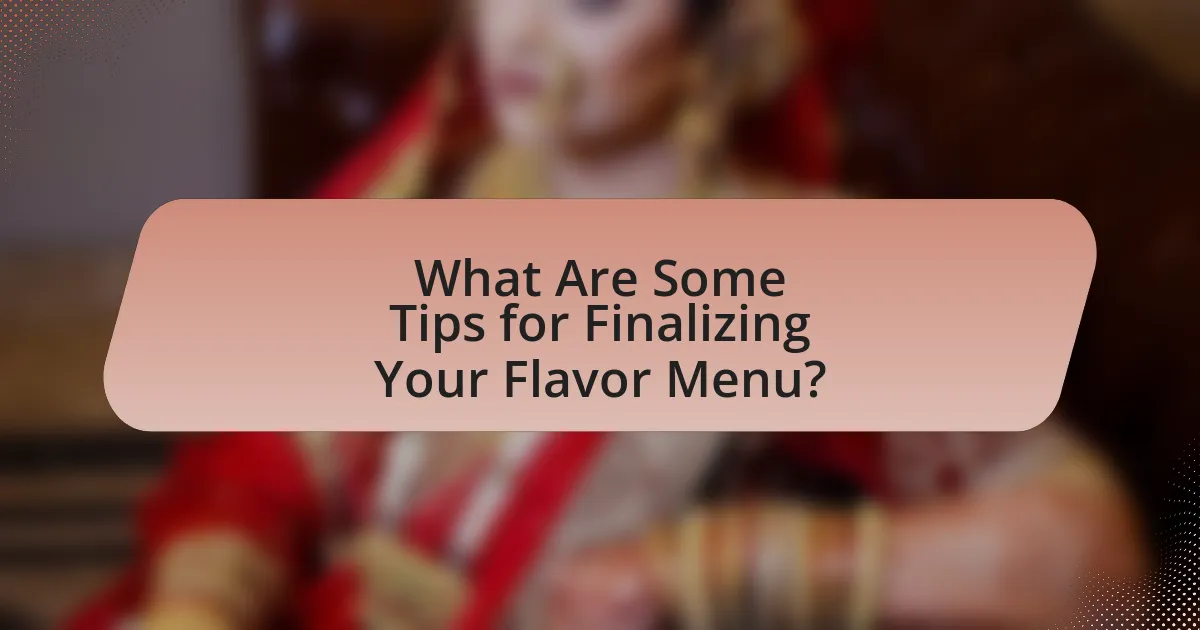A flavor menu for a wedding cake is a curated selection of cake flavors and fillings that allows couples to personalize their cake according to their tastes and preferences. This article outlines the importance of a flavor menu in enhancing guest satisfaction and creating memorable experiences at weddings. It discusses the elements to consider when designing a flavor menu, such as dietary restrictions and seasonal ingredients, and provides guidance on brainstorming flavor ideas, testing combinations, and presenting options effectively. Additionally, it highlights common mistakes to avoid and best practices for ensuring that the flavor menu caters to diverse palates while reflecting the couple’s unique story.

What is a Flavor Menu for Your Wedding Cake?
A flavor menu for your wedding cake is a curated list of cake flavors and fillings that couples can choose from to personalize their wedding cake. This menu typically includes a variety of options, such as classic flavors like vanilla and chocolate, as well as unique combinations like lemon raspberry or red velvet. The purpose of a flavor menu is to allow couples to select flavors that reflect their tastes and preferences, ensuring that the cake is not only visually appealing but also delicious. Many bakeries offer tasting sessions to help couples decide on their preferred flavors, enhancing the overall wedding experience.
Why is a Flavor Menu Important for Your Wedding Cake?
A flavor menu is important for your wedding cake because it allows you to cater to diverse tastes and preferences among your guests. By offering a variety of flavors, you enhance the overall experience of the celebration, ensuring that everyone can enjoy a slice that appeals to their palate. Research indicates that 70% of guests remember the taste of the wedding cake, making flavor selection a critical aspect of wedding planning. Additionally, a well-curated flavor menu can reflect the couple’s personality and story, adding a personal touch to the event.
How does a Flavor Menu enhance the overall wedding experience?
A Flavor Menu enhances the overall wedding experience by providing guests with a diverse selection of cake flavors that cater to various tastes and preferences. This personalization fosters a more inclusive atmosphere, allowing guests to enjoy a unique culinary experience that reflects the couple’s personality and style. Additionally, offering a variety of flavors can create memorable moments, as guests often share their favorites and engage in discussions about the different options. Research indicates that personalized food experiences can significantly increase guest satisfaction at events, reinforcing the importance of a well-curated Flavor Menu in elevating the wedding celebration.
What role does flavor play in wedding cake selection?
Flavor is a critical factor in wedding cake selection as it directly influences guest satisfaction and overall enjoyment of the event. The chosen flavors can reflect the couple’s personal tastes and preferences, making the cake a meaningful centerpiece. Additionally, popular flavor combinations, such as vanilla with raspberry or chocolate with salted caramel, can enhance the cake’s appeal, ensuring it complements the wedding theme and atmosphere. Research indicates that 70% of guests consider the taste of the cake as a key element of their overall experience at weddings, highlighting the importance of flavor in creating memorable moments.
What Elements Should be Considered in a Flavor Menu?
A flavor menu for a wedding cake should consider the variety of flavor profiles, dietary restrictions, seasonal ingredients, and pairing options. Variety ensures that guests with different preferences can find something appealing, while dietary restrictions, such as gluten-free or vegan options, accommodate all attendees. Seasonal ingredients enhance freshness and taste, making the cake more enjoyable. Pairing options, such as complementary fillings and frostings, create a harmonious overall flavor experience. These elements collectively contribute to a well-rounded and inclusive flavor menu for a wedding cake.
How do personal preferences influence flavor choices?
Personal preferences significantly influence flavor choices by guiding individuals toward tastes that resonate with their experiences and cultural backgrounds. For instance, someone raised in a family that frequently enjoyed citrus desserts may gravitate toward lemon or orange flavors for their wedding cake. Research indicates that flavor preferences are shaped by early exposure to certain tastes, which can create lasting associations and emotional connections. A study published in the journal “Appetite” by authors such as van der Lans et al. (2014) found that personal experiences and cultural factors play a crucial role in determining flavor preferences, further validating the impact of personal history on flavor selection.
What seasonal ingredients can be incorporated into the flavor menu?
Seasonal ingredients that can be incorporated into the flavor menu include fresh fruits like strawberries in spring, peaches in summer, apples in fall, and citrus fruits in winter. These ingredients enhance the flavor profile of wedding cakes by providing natural sweetness and vibrant flavors that align with the seasons. For example, strawberries are at their peak in late spring, making them ideal for a light, refreshing cake, while apples can be used in spiced cakes during the fall harvest season.

How Can You Create a Flavor Menu for Your Wedding Cake?
To create a flavor menu for your wedding cake, start by selecting a variety of cake flavors that appeal to you and your partner, such as vanilla, chocolate, red velvet, or lemon. Next, consider incorporating complementary fillings and frostings, like cream cheese, ganache, or fruit preserves, to enhance the overall taste experience. Additionally, you can offer a tasting session with your baker to finalize the flavors based on personal preferences and seasonal ingredients. This approach ensures that the flavor menu reflects your unique tastes while also catering to your guests’ preferences.
What Steps are Involved in Designing a Flavor Menu?
Designing a flavor menu involves several key steps. First, identify the target audience and their preferences to ensure the flavors resonate with them. Next, research popular and trending flavors in wedding cakes, considering seasonal ingredients and unique combinations. Then, create a balanced selection of flavors, including classic options like vanilla and chocolate, alongside innovative choices such as lavender or matcha. After that, conduct taste tests to refine the flavor profiles and ensure quality. Finally, present the flavor menu in an appealing format, highlighting descriptions that evoke the taste experience. This structured approach ensures a well-rounded and enticing flavor menu for wedding cakes.
How do you start brainstorming flavor ideas?
To start brainstorming flavor ideas for a wedding cake, begin by considering popular flavor combinations that resonate with the couple’s preferences and the wedding theme. Research indicates that classic flavors like vanilla, chocolate, and red velvet are frequently chosen for wedding cakes, while unique combinations such as lemon and lavender or chocolate and raspberry can add a personal touch. Engaging in discussions with the couple about their favorite desserts, seasonal ingredients, and cultural influences can further inspire innovative flavor ideas.
What factors should you consider when narrowing down your options?
When narrowing down your options for a wedding cake flavor menu, consider taste preferences, dietary restrictions, seasonal availability, and the overall theme of the wedding. Taste preferences are crucial as they reflect the couple’s and guests’ likes, ensuring enjoyment. Dietary restrictions, such as allergies or vegan choices, must be addressed to accommodate all guests. Seasonal availability impacts freshness and flavor, as certain ingredients are better at specific times of the year. Lastly, aligning the cake flavors with the wedding theme enhances the overall experience, creating a cohesive celebration.
How Can You Incorporate Different Flavor Profiles?
To incorporate different flavor profiles into a wedding cake, select a variety of complementary and contrasting flavors that appeal to diverse palates. For instance, pairing a rich chocolate cake with a light raspberry filling creates a balance between sweetness and tartness, enhancing the overall taste experience. Additionally, incorporating spices like cinnamon or cardamom can add depth to traditional flavors, while using unique ingredients such as lavender or matcha can introduce unexpected yet delightful notes. Research indicates that flavor pairing based on chemical compounds can enhance the perception of taste, making it essential to consider both classic combinations and innovative pairings for a well-rounded flavor menu.
What are the popular flavor combinations for wedding cakes?
Popular flavor combinations for wedding cakes include vanilla and almond, chocolate and raspberry, lemon and blueberry, red velvet and cream cheese, and carrot cake with cream cheese frosting. These combinations are favored for their balance of sweetness and complementary flavors, appealing to a wide range of palates. For instance, vanilla and almond create a classic taste, while chocolate and raspberry offer a rich and fruity contrast. Lemon and blueberry provide a refreshing option, and red velvet with cream cheese is a popular choice for its unique color and flavor profile. Carrot cake with cream cheese frosting is also beloved for its moist texture and spiced flavor.
How can you balance traditional and modern flavors?
To balance traditional and modern flavors in a wedding cake, incorporate classic ingredients with contemporary techniques or flavor profiles. For example, use a traditional vanilla or chocolate base while infusing it with modern elements like matcha or salted caramel. This approach allows for a familiar taste that resonates with guests while introducing innovative flavors that excite the palate. Historical data shows that flavor fusion has become increasingly popular in culinary trends, with a 2021 survey indicating that 60% of couples prefer unique flavor combinations for their wedding cakes, blending nostalgia with novelty.

What Are Some Tips for Finalizing Your Flavor Menu?
To finalize your flavor menu for a wedding cake, prioritize a balance of popular and unique flavors that cater to diverse tastes. Start by surveying guests or considering common preferences, such as vanilla, chocolate, and red velvet, while also incorporating distinctive options like lavender or lemon basil to create excitement. Additionally, ensure that the flavors complement each other and the overall theme of the wedding, as harmonious pairings enhance the cake’s appeal. Finally, conduct taste tests with a small group to gather feedback, which can help refine the final selections and ensure satisfaction.
How Can You Test Your Flavor Combinations?
To test your flavor combinations, conduct a series of taste tests with small batches of your selected flavors. This method allows you to evaluate how well the flavors complement each other and identify any potential imbalances. For instance, pairing sweet flavors with acidic or bitter notes can enhance the overall profile, as supported by culinary principles that emphasize balance in taste. Additionally, gathering feedback from a diverse group of tasters can provide insights into preferences and perceptions, ensuring that the final flavor menu resonates with a wider audience.
What methods can be used for tasting and feedback?
Methods for tasting and feedback include structured tasting sessions, surveys, and one-on-one interviews. Structured tasting sessions involve presenting a variety of cake flavors to a group, allowing participants to evaluate each flavor based on specific criteria such as taste, texture, and aroma. Surveys can be distributed after tastings to gather quantitative data on preferences, while one-on-one interviews provide qualitative insights into individual experiences and suggestions. These methods ensure comprehensive feedback, enabling cake creators to refine their flavor offerings based on direct consumer input.
How do you ensure the flavors complement each other?
To ensure the flavors complement each other, it is essential to balance contrasting and similar flavor profiles. For instance, pairing a rich chocolate cake with a light raspberry filling creates a harmonious contrast that enhances both flavors. Additionally, using complementary ingredients, such as vanilla with almond or citrus with herbs, can elevate the overall taste experience. Research indicates that flavor pairing based on chemical compounds, such as those outlined in “The Flavor Bible” by Karen Page and Andrew Dornenburg, supports the idea that certain flavors naturally enhance one another, providing a scientific basis for these combinations.
What Common Mistakes Should You Avoid When Creating a Flavor Menu?
When creating a flavor menu for a wedding cake, common mistakes to avoid include offering too many options, neglecting flavor balance, and failing to consider dietary restrictions. Offering an excessive number of flavors can overwhelm guests and dilute the overall experience; research indicates that too many choices can lead to decision fatigue. Neglecting flavor balance may result in combinations that clash, making the cake less enjoyable; for instance, pairing overly sweet flavors without a contrasting element can lead to an unpalatable dessert. Additionally, not accounting for dietary restrictions, such as gluten-free or nut allergies, can alienate guests and limit their enjoyment of the cake. These mistakes can significantly impact the overall success of the wedding cake experience.
How can overcomplicating flavors affect your cake?
Overcomplicating flavors can negatively impact your cake by overwhelming the palate and masking the intended taste. When too many flavors are combined, it can lead to a lack of harmony, making it difficult for any single flavor to stand out. This can result in a confusing eating experience, where the cake may taste muddled rather than cohesive. Studies in culinary arts emphasize that balance and simplicity often yield the most enjoyable flavors, as seen in classic recipes that focus on a few key ingredients to create depth without complexity.
What should you consider about guest preferences and dietary restrictions?
When creating a flavor menu for your wedding cake, you should consider the specific dietary restrictions and preferences of your guests. This includes identifying common allergens such as nuts, gluten, dairy, and eggs, as well as accommodating dietary choices like veganism or vegetarianism. According to a survey by The Knot, 30% of couples reported that they considered dietary restrictions when planning their wedding menus, highlighting the importance of inclusivity. By gathering information on your guests’ dietary needs in advance, you can ensure that everyone has a suitable option, enhancing their overall experience at your wedding.
What Are Best Practices for Presenting Your Flavor Menu?
The best practices for presenting your flavor menu include clear organization, appealing visuals, and concise descriptions. Organizing the menu by categories, such as classic, seasonal, or unique flavors, helps customers navigate easily. Using high-quality images of the cakes enhances visual appeal and can influence customer choices. Concise descriptions that highlight key ingredients and flavor profiles provide essential information without overwhelming the reader. Research indicates that menus with appealing visuals and clear organization can increase customer engagement and satisfaction, leading to higher sales.
How can you visually display the flavor options at your wedding?
To visually display the flavor options at your wedding, create an elegant flavor menu that showcases each cake flavor alongside appealing visuals. This can be achieved by using a decorative board or easel that features high-quality images of each cake flavor, paired with descriptive text highlighting key ingredients and flavor profiles. Research indicates that visual aids significantly enhance guest engagement and decision-making, as seen in studies on menu design in hospitality settings. By incorporating attractive visuals and clear descriptions, you effectively communicate the variety of flavors available, making it easier for guests to choose their preferences.
What information should be included for each flavor option?
Each flavor option should include the flavor name, a description of the taste profile, key ingredients, and any dietary considerations. The flavor name identifies the option, while the taste profile description provides insight into the flavor experience, such as sweetness or richness. Key ingredients inform customers about the primary components, which is essential for those with allergies or dietary restrictions. Dietary considerations, such as gluten-free or vegan status, ensure that all guests can enjoy the cake. This structured information helps customers make informed choices when selecting flavors for their wedding cake.
